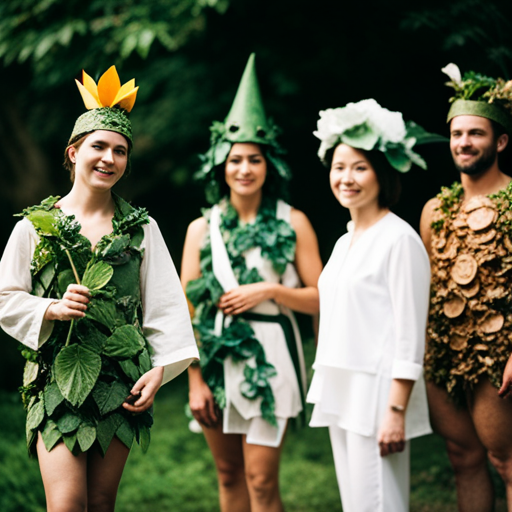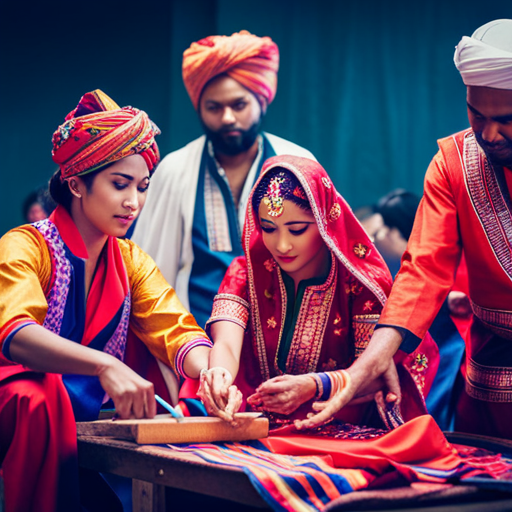Crafting Costumes for Music Videos: A Guide

Did you know that 90% of music videos incorporate unique and visually captivating costumes to enhance the artistic experience?
In this comprehensive guide, we delve into the intricate process of crafting costumes for music videos.
From understanding the artist’s vision to sourcing materials and executing intricate designs, this article provides valuable insights and techniques for creating visually stunning and impactful costumes that bring the artist’s vision to life on screen.
Understanding the Artist’s Vision
To create costumes that resonate with the artist’s vision for a music video, it is essential to thoroughly understand and interpret their creative direction. This involves a deep level of artist collaboration and creative interpretation. The process begins with extensive discussions to grasp the artist’s concept, theme, and message. It’s crucial to understand their aesthetic preferences, style, and the emotions they aim to evoke through the music video. This collaborative approach allows the costume designer to align their creative vision with that of the artist, ensuring a cohesive and impactful visual narrative.
Creative interpretation plays a pivotal role in understanding the artist’s vision. It involves not only comprehending their explicit instructions but also interpreting their implicit cues, such as their body language, tone, and references to other works of art. This deeper understanding enables the costume designer to infuse their designs with elements that authentically reflect the artist’s essence. By integrating the artist’s personality and vision into the costumes, the designer can elevate the visual storytelling, creating a seamless connection between the artist’s music and their persona.
This level of understanding and interpretation ultimately results in costumes that enhance the music video’s narrative and resonate deeply with the audience.
Sourcing Materials and Inspiration
Understanding the artist’s vision is paramount in sourcing materials and inspiration for crafting costumes that resonate with the music video’s creative direction. Material exploration and creative sourcing play a crucial role in bringing the artist’s vision to life. Here are some ways to evoke emotion in the audience:
-
Texture and Fabric: Delve into a variety of textures and fabrics to create depth and visual interest in the costumes, evoking tactile and visual sensations.
-
Color Palette: Use a carefully curated color palette to convey emotions, from vibrant and energetic hues to muted and melancholic tones, evoking varied emotional responses.
-
Historical Influences, Modern Inspiration: Draw inspiration from historical fashion trends and reinterpret them with a modern twist, creating a sense of nostalgia and innovation simultaneously.
-
Symbolism and Cultural References: Incorporate symbols and cultural references in the costumes to evoke deeper emotional connections and resonate with the audience on a cultural and personal level.
By sourcing materials and inspiration with these elements in mind, the costumes will effectively convey the intended emotions and complement the music video’s creative direction.
Transitioning into the subsequent section about ‘designing and sketching costume concepts’, it is essential to translate the sourced materials and inspiration into tangible costume designs.
Designing and Sketching Costume Concepts
Drawing from the sourced materials and inspiration, the process of designing and sketching costume concepts bridges the artistic vision with tangible representations, ensuring a cohesive alignment with the music video’s creative direction.
When sketching costume concepts, it is essential to employ various sketching techniques to effectively communicate design ideas. Utilizing techniques such as rough sketches, detailed illustrations, and technical drawings helps in conveying the intricacies of the costumes. Moreover, considering color palettes is crucial during the sketching phase to capture the mood and tone intended for the music video. Experimenting with different color combinations and swatches aids in finalizing the visual aesthetic of the costumes. Additionally, it is imperative to pay attention to how the colors complement the overall visual scheme of the music video.
Transitioning into the subsequent section about ‘fabrication and construction techniques’, the finalized costume sketches serve as the blueprint for fabricating and constructing the actual costumes. These sketches provide a clear direction for the fabrication team, ensuring that the envisioned costumes are brought to life with precision and accuracy.
Fabrication and Construction Techniques
Executing the costume designs through precise fabrication and construction techniques is a critical phase in bringing the envisioned costumes to life for music video productions. To ensure the highest quality and visual impact, the following techniques are essential:
-
Sewing Techniques: Utilizing advanced sewing techniques such as hand-stitching, appliqué, and intricate embroidery can elevate the overall aesthetic of the costume, adding depth and texture to the design.
-
Costume Construction: Employing expert costume construction methods, including pattern-making, draping, and tailoring, is fundamental in achieving a flawless fit and enhancing the overall visual appeal of the costumes.
-
Fabric Selection: The careful selection of fabrics, considering factors such as drape, weight, and texture, is crucial in realizing the intended look and feel of the costumes, ensuring they complement the artistic vision of the music video.
-
Embellishment Methods: Incorporating embellishments such as beading, sequins, and fabric manipulation techniques can add an extra layer of sophistication and visual interest to the costumes, captivating the audience and enhancing the on-screen performance.
Styling and Coordination for Visual Impact
Continuing with the meticulous craftsmanship established in the previous subtopic, the styling and coordination for visual impact play a pivotal role in enhancing the overall aesthetic of the costumes for music video productions. Color coordination is essential in creating visually striking costumes. It is crucial to consider the color palette of the set, lighting, and the overall theme of the music video. By coordinating the colors of the costumes with these elements, a cohesive and visually appealing look can be achieved.
Fabric selection is equally important in styling costumes for music videos. The type of fabric chosen can greatly impact the overall visual impact of the costumes. Different fabrics drape and move in distinct ways, which can enhance the performance and visual appeal of the artist. Additionally, the fabric choice can influence the color saturation and texture of the costumes under different lighting conditions, further emphasizing the importance of fabric selection in creating impactful costumes for music videos.
Frequently Asked Questions
How Do You Ensure the Costumes Are Comfortable for the Performers to Wear During Long Music Video Shoots?
Comfort considerations are paramount for performers during long music video shoots. To ensure this, costumes should be made with breathable, flexible fabrics and tailored for ease of movement. Prioritizing performance endurance helps to maintain the energy and quality of the production.
What Considerations Should Be Made for Costumes in Terms of Lighting and Camera Angles for Music Video Shoots?
Lighting considerations for music video costumes are crucial to ensure the outfits stand out and are appropriately illuminated. Camera angle adjustments play a key role in capturing the costumes effectively, highlighting their details and enhancing visual impact.
How Do You Handle Costume Changes and Quick Alterations on Set During Music Video Production?
Handling emergencies, costume maintenance, and quick changes are vital during music video production. On set, having a dedicated wardrobe team and a well-organized wardrobe kit facilitates swift alterations, ensuring seamless transitions between scenes.
What Are Some Common Challenges Faced When Creating Costumes for Music Videos, and How Do You Overcome Them?
When creating costumes for music videos, common challenges include performer comfort and lighting considerations. Solutions involve using breathable fabrics and considering how the costumes will interact with the lighting to ensure the best visual impact.
How Do You Take Into Account the Artist’s Personal Style and Brand When Designing Costumes for Their Music Videos?
When designing costumes for music videos, it is essential to consider the artist’s personal style and brand. This involves a deep understanding of their artistic expression and a meticulous alignment with their branding to ensure a cohesive visual representation.
Conclusion
In conclusion, crafting costumes for music videos requires a deep understanding of the artist’s vision, as well as the ability to source materials and inspiration for the design process.
The use of fabrication and construction techniques, along with styling and coordination, is essential for achieving visual impact.
By following these steps, costume designers can create compelling and visually stunning costumes that enhance the overall artistic vision of the music video.

Rufus Whitver is a passionate costume artisan and the creative mind behind layuo.com. With a keen eye for detail and a flair for imaginative design, Rufus brings characters to life through the art of costume making. His expertise encompasses a wide range of styles, from historical recreations to fantastical creations. Through layuo.com, Rufus shares insights, tutorials, and a portfolio showcasing his exceptional craftsmanship, inspiring fellow enthusiasts to embark on their own journey into the world of stunning costumes.




